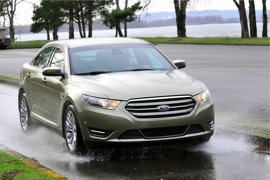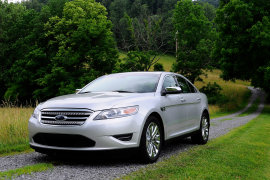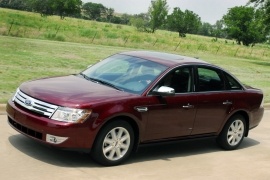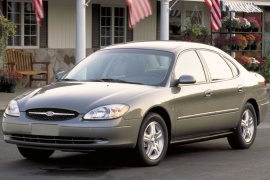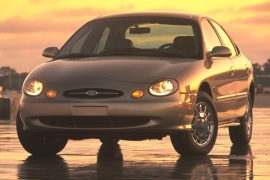FORD Taurus Models/Series Timeline, Specifications & Photos
First production year: 1995
Engines: Gasoline
Ford unveiled the 2012 Taurus at the 2011 New York Auto Show. It was a mild-facelift to push the car's sales. The most important changes were from the technological side, but some aesthetic changes were made as well.
The 2012 Taurus was made greener for the entire range. The electronic power steering was implemented on all versions of the car. Another important improvement was the automatic fuel shutoff during aggressive deceleration.
From the outside, there was a new grille in the front, with three slimmer horizontal chromed slats on an octagonal shape. The headlights were changed as well to fit the new front fascia design.
Inside, the 2012 Taurus featured a MyFord Touch infotainment unit, which incorporated some of the older buttons with new, touch, ones on the screen. The seats were changed and their foam was made out of soy instead of petroleum-based materials. Ford has committed itself to make the car greener in more aspects, not just the engines.
For the engine compartment, the car-maker installed a new 2.0-liter turbocharged and direct fuel-injection system, on the EcoBoost engine generation. It offered more power and torque than the one it replaced it. The V6 version, with a 3.5-liter displacement, offered 27 hp more power due to the addition of twin independent variable camshaft timing (Ti-VCT). Both versions were mated to a standard 6-speed automatic transmission.
While the 2008 Taurus was more of a rebadged Five Hundred, the 2010 model came as a fully-pledged sixth generation of this nameplate on the market.
Coming after the years of the world financial crisis, the sixth generation of the Taurus had to rely on parts designed in the past and couldn't be replaced with completely new ones. In addition, the car was built on top of a D3 platform, which was a revised version of Volvo's P2 architecture, but with steel suspension arms instead of aluminum. But fortunately, the car sported independent suspension in all corners, and that made the big Taurus a more comfortable car.
From the design point of view, the sixth generation of the Taurus was a huge improvement over its predecessor. It featured slimmer headlights and a narrower three-slat grille between them. The lower bumper sported a center trapezoidal-shaped grille, which resembled the one installed on the European's Mondeo. From its profile, the arched roofline with its raked forward C-pillars evoked the cab-forward design. At the back, the blue-oval brand dared to cross the limit of the quarter panels with the taillights, which were extended on the trunk lid.
Inside, the car offered a generous cabin fit for five. The dashboard, with its double-bubble design, resembled the one from the Mustang. At the same time, the center stack hosted the infotainment screen, the buttons for the sound system, and the HVAC controls.
Underneath the hood, Ford installed a transversely-mounted 3.5-liter V6 from the Duratec family. It sent its power to the front or to all wheels, depending on the trim level and options.
Based on the same platform as the Five Hundred, which it replaced, the Taurus used the old name again to revive Ford's full-size sedan in 2006 as a 2007 model.
Even though it wasn't a completely new vehicle, the 5G Taurus gained on the market due to its nameplate popularity and exterior styling. While the vehicle's main shape remained the same, both ends were dramatically changed in a good way. The Taurus, and its predecessor, were the first full-size sedans built by Ford in the U.S., which featured fully independent suspension and an all-wheel-drive system. Volvo developed the platform before the American brand bought it in 1999.
At the front, the Taurus adopted the three-bar horizontal grille design already used by other vehicles from the blue-oval brand lineup, including SUVs and trucks. Its new headlights design with raked front end and curved surfaces were very appealing for the customers. Two fake air-vents on the front fenders increased the car's visibility. A clear lens covered the triangular taillights with the reversing light on the upper side.
Inside, Ford designed an airy cabin with a curved dashboard. On the center stack, the carmaker installed an infotainment system named SYNC developed together with Microsoft, which allowed good connectivity with mobile phones and other storage devices. It featured voice commands which were easy to understand in the quiet interior. A long list of safety features made the Taurus a five-star winner in the NHTSA crash tests.
Worth mentioning that the Taurus was more powerful than the Five Hundred, and it was available with a front- or all-wheel-drive. Even though it featured only one engine option, that was paired to a standard 6-speed automatic transmission.
After banging their heads against the walls, Ford's design department came to its senses and replaced the Taurus' third generation with a different vehicle.
It was unusual for Ford to redesign a car after just four years on the market, but the third generation of the Taurus featured an uninspired design, to say at least, and that was directly reflected in the car's sales. If the designers were happy with the bug-eye headlights, the marketing, and the sales departments weren't. So, the design team had to go back and come with a new version. The engineers have mostly left aside since the Taurus' fourth-generation sported a slightly different platform than its predecessor.
The new headlights swept-back to the front fenders were the most noticeable difference when compared with the round headlamps from its predecessor, but the elliptic grille shape was similar. In the back, Ford installed corner-mounted taillights that followed the new-edge design trend already initiated by the Ford Focus.
Inside, the fourth-gen Taurus featured a dashboard with a less controversial look, with the instrument cluster's upper side extended over the center console. A trapezoidal-shaped audio system replaced the previous one, which looked like an egg.
For the engine compartment, Ford installed a choice of two V6 engines with a similar displacement, with power up to 201 hp. All versions were mated to a standard 4-speed auto, with a floor-mounted shifter.
The Taurus was one of the best selling cars in America for over a decade, after its first generation launch in 1986. The 1995 model came with a totally new design.
The first generation of the Taurus was built to replace the older Ford LTD and it represented the transition to front-wheel-drive for the mid-size family sedan. After nine years, the third generation was introduced and it had to continue the winning streak of the Taurus. But it didn't.
While its predecessors featured a conservative design, the fourth generation of the Taurus dared to be different. It was the era of biodesign and Ford tried that in a conservative market. The oval shape of the logo was the inspiration design element for the whole car. The dual oval headlights were accompanied by oval-shaped side windows and an oval rear windscreen.
The interior repeated the oval theme on the center stack where the climate controls and the stereo were incorporated into an oval-shaped black plastic. Even the instrument cluster was elliptical. Despite the design, the car featured sufficient room for up to six adults, with an intelligent front bench. In the rear, the Taurus featured a three-point seatbelt for the middle passenger, a first for its class.
For the engine compartment, Ford installed a choice of three V6 engines ranged from 3.0- to 3.4-liter with power up to 238 hp. All three versions were mated to a standard 4-speed auto, with a steering-column shifter.
